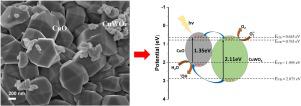Materials Today Communications ( IF 3.7 ) Pub Date : 2020-11-22 , DOI: 10.1016/j.mtcomm.2020.101886 Angela Mercedes Raba-Páez , João Otávio D. Malafatti , Carlos Arturo Parra-Vargas , Elaine Cristina Paris , Miryam Rincón-Joya

|
Several studies reported that modifying CuO with CuWO4 can increase its photoactivity. In this study, copper and tungsten heterostructure materials were synthesized via a simple sol-gel method using ammonium paratungstate. The temperature’s influence (300, 500, 700, and 900 °C) was analyzed in the structural, morphological, microstructural, and optical properties of Cu and W materials using X-ray diffraction, infrared spectroscopy, field emission-scanning electron microcopy, transmission electron microscopy, diffuse reflectance spectroscopy, and dynamic light-scattering studies. The CuO diffraction patterns exhibited a tenorite phase formation, and the copper-tungsten materials diffractograms demonstrated the formation of CuO/CuWO4 at 300 and 500 °C and CuO/CuWO4/Cu2WO4/WO3 materials at 700 and 900 °C with crystallite sizes from 25 to 56 nm. Intense vibrational modes obtained at 300 °C for the CuWO4 phase decreased at 500 °C. Therefore, 500 °C is not a temperature that promotes CuO/CuWO4 heterostructure formation. Analyses conducted using microscopy techniques demonstrated the morphology of the CuO/CuWO4 heterostructure obtained at 300 °C, where CuWO4 nanoparticles covered the CuO polyhedral; microstructural analysis verified the heterostructure’s formation. The synthesized materials at 300 °C had an optical band gap of 2.66 eV (direct gap) and 1.35 eV and 2.11 eV (indirect gap), which were lower values than those of the CuO and CuWO4. The temperature at 300 °C proved to be optimal for the formation of the CuO/CuWO4 heterostructure. Only the material obtained at 300 °C exhibited a photocatalytic response in the rhodamine B degradation due to a possible interfacial charge transfer between the CuWO4 and CuO. The synthesis process used to obtain the CuO/CuWO4 heterostructure was novel, with a short processing time, low energy consumption and cost, and environmentally friendly properties.
中文翻译:

铜和钨异质结构材料的结构演变,光学性质和光催化性能
几项研究报道,用CuWO 4改性CuO可以提高其光活性。在这项研究中,铜和钨异质结构材料是使用对钨酸铵通过简单的溶胶-凝胶法合成的。利用X射线衍射,红外光谱,场发射扫描电子显微镜,透射电镜,分析了温度对300和500、700和900°C温度的影响,分析了铜和钨材料的结构,形态,微结构和光学性质。电子显微镜,漫反射光谱和动态光散射研究。CuO衍射图样表现出红铁矿相的形成,铜钨材料衍射图表明在300和500°C时形成CuO / CuWO 4以及CuO / CuWO 4/ Cu 2 WO 4 / WO 3材料在700和900°C下具有25至56 nm的微晶尺寸。CuWO 4相在300°C下获得的强烈振动模式在500°C下下降。因此,500℃不是促进CuO / CuWO 4异质结构形成的温度。使用显微镜技术进行的分析表明,在300°C下获得的CuO / CuWO 4异质结构的形态,其中CuWO 4纳米颗粒覆盖了CuO多面体;微观结构分析证实了异质结构的形成。合成材料在300°C时的光学带隙为2.66 eV(直接间隙),而带隙为1.35 eV和2.11 eV(间接间隙),低于CuO和CuWO 4的值。事实证明,300°C的温度最适合形成CuO / CuWO 4异质结构。由于在CuWO 4和CuO之间可能发生界面电荷转移,仅在300°C下获得的材料在罗丹明B降解中显示出光催化响应。用于获得CuO / CuWO 4的合成工艺 异质结构新颖,加工时间短,能耗和成本低,并且具有环保特性。











































 京公网安备 11010802027423号
京公网安备 11010802027423号